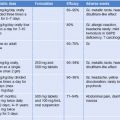CHAPTER 21 Eosinophilia
Introduction
Definition of eosinophilia
Eosinophilia can be defined as an absolute eosinophil count greater than 450/mm3 in the peripheral blood. Physiologically, eosinophil levels in the peripheral blood have a diurnal variation with a peak in the morning, a time at which endogenous steroids are the lowest. Eosinophil levels are relatively high at birth, decrease during childhood, and can decline further during pregnancy.1 Eosinophils are more abundant in tissues, particularly in those tissues with a mucosal–environmental interface such as the respiratory, gastrointestinal, and genitourinary tracts.
Epidemiology
Among immigrant and refugee populations, the prevalence of peripheral blood eosinophilia defined as > 450/mm3 or > 500/mm3 has been shown to range from 12% to 53% of those screened.2–10
Although immigrants and refugees may have parasitic helminth infection, the absence of eosinophilia does not exclude parasitic infection.3 It is known that eosinophilia has a relatively poor predictive value (both negative and positive)4,11,12 for parasitic infection in returning travelers. However, eosinophilia in asymptomatic refugees and/or immigrants should draw attention to possible parasitic infections, as those with lifelong exposure to parasitic infections are more often asymptomatic compared to short-term travelers. In one study of Southeast Asian refugees with persistent eosinophilia and a negative initial screening evaluation, 95% were found to have gastrointestinal parasites with one or multiple organisms (55% with hookworm and 38% with Strongyloides).6 Indeed, many of the tissue-invasive helminth infections (strongyloidiasis, filariasis, schistosomiasis) are associated with clinically asymptomatic conditions in chronic infections.13–16 Moreover, in a study from a parasite-endemic region of Brazil, high-grade eosinophilia was more likely to be associated with parasite infection, and higher eosinophil counts were associated with having more than one infecting species of parasites in the same host (polyparasitism).17
Even in immigrant populations that have emigrated in the distant past, it must be remembered that some parasites (filarial parasites) have life spans that can exceed 10–15 years, and others have autoinfective cycles (Strongyloides) that enable lifelong parasite persistence. Indeed, the chronicity of infection, one of the hallmarks of helminth parasites, has been well documented, as can be seen in Table 21.1. Immigrants can also acquire new infections from visits back to their home country (so-called ‘visiting friends and relatives’).
Table 21.1 Documented length of infection in selected parasites
| Pathogen (disease) | Length of infection (years) |
|---|---|
| S. stercoralis (strongyloidiasis) | 60+ |
| Schistosoma spp. (schistosomiasis) | 32 |
| E. granulosis (hydatid disease) | >20 |
| T. spiralis larvae in muscle (trichinellosis) | 18 |
| T. solium (cysticercosis) | >15 |
| W. bancrofti (lymphatic filariasis) | 5–10 |
| L. loa (loiasis) | 16–24 |
| O. volvulus (onchocerciasis) | 10–15 |
| N. americanus (hookworm disease) | 3–5 |
| A. lumbricoides (ascariasis) | 1–1.5 |
Pathophysiology
It has been suggested that eosinophils play an important role in the immune response to helminth infec tion, based on the observation of eosinophils surrounding dying parasites in an animal infection model of Nippostrongylus brasiliensis.18 Eosinophilia and increased serum IgE levels are characteristic of helminth infection which reflects the production of cytokines such as interleukins (IL-4 and IL-5) from CD4+ lymphocytes. In addition to IL-5 – the main cytokine responsible for the specific development of eosinophils – other cytokines (e.g. IL-4 and IL-13) and chemokines (e.g. RANTES and eotaxin) are important for the recruitment of eosinophils from the blood to the tissues.19
The degree of eosinophilia may also vary based on the parasites’ tissue distribution pattern, their migration route, the maturation stage of the parasites and the actual parasite burden.20,21 Eosinophilia is often particularly pronounced in the early phase of infection, when developing larvae migrate through the lungs (e.g. Ascaris or Strongyloides) or through other tissues (as in hookworm and Trichinella infection). Because of the long prepatent period characteristic of some helminth infections, eosinophilia may occur at a time when parasitologic diagnosis is difficult (prior to egg secretion or antibody positivity). In most instances, eosinophil levels from helminth parasites gradually diminish over time (even without anthelmintic treatment), although they rarely return to normal levels.
The kinetics of parasite infection-associated eosinophilia varies widely depending on the particular species of infecting parasite. In a human volunteer study with Necator americanus, it was shown that blood eosinophil counts began to rise from baseline 2–3 weeks after infection and reached a peak between 38 and 64 days.22 In several experimental human filarial infections, peak eosinophil counts occurred 11–30 weeks after the initiation of infection.23 In both types of infections there was a natural modulation (diminution) of the eosinophil levels over time.
Therefore, in immigrants or refugees who have been chronically exposed to helminth infection for an extended period of time, eosinophilia may be less prominent than in travelers infected from relatively recent exposure.13
Etiology
Many of the causes of eosinophilia resulting from infectious and noninfectious processes are detailed in Table 21.2.
Table 21.2 Symptoms and etiologies associated with eosinophilia
VLM, visceral larva migrans.
Infectious causes
Major episodes of eosinophilia in immigrants or refugees from tropical or subtropical countries are induced by infections with multicellular helminthic worms that include nematodes (roundworms), cestodes (tapeworms), and trematodes (flukes). Accompanying localizing symptoms associated with eosinophilia can provide insights into the potential underlying diagnosis associated with the eosinophilia (see Table 21.2).
The parasitic diseases associated with peripheral blood eosinophilia include: angiostrongyliasis, anisakiasis, ascariasis, capillariasis, clonorchiasis, cysticercosis, dicrocoeliosis, echinococcosis, echinostomiasis, enterobiasis, fascioliasis, fasciolopsiasis, filariasis, gnathostomiasis, heterophyiasis, hookworm infection, hymenolepiasis, metagonimiasis, opisthorchiasis, paragonimiasis, schistosomiasis, sparganosis, strongyloidiasis, toxocariasis (e.g. visceral larval migrans), trichinellosis, and trichuriasis. Among these, those most commonly identified among immigrant or refugee populations in association with eosinophilia are ascariasis, filarial infections, hookworm infections, schistosomiasis, strongyloidiasis, trichuriasis, and toxocariasis.2,6,10,11,24,25
In general, protozoan infection does not cause eosinophilia, with the exception of isosporiasis, known to cause diarrhea associated with eosinophilia in both immunocompetent and immunocompromised patients.26,27 Infection with Blastocystis hominis has also been shown to present with chronic urticaria or diarrhea associated with mild eosinophilia in rare cases.28,29 In general, most patients with B. hominis do not require treatment provided they are asymptomatic. Moreover, typically the presence of the B. hominis should not be considered an explanation of the peripheral blood eosinophilia. Eosinophilia can be caused by ectoparasites. Scabies can cause eosinophilia, presumably due to hypersensitivity reactions to the mites and their eggs.30 Myiasis – a condition caused by infestation of fly larvae in the skin, subcutaneous tissue, and/or other internal organs – has also occasionally been associated with eosinophilia.31
Most acute bacterial and viral diseases are associated with eosinopenia, the exceptions being resolving scarlet fever, chronic indolent tuberculosis32 and HIV infection.33 Occasionally, fungal infections such as coccidioidomycosis,34 paracoccidioidomycosis,35–39 aspergillosis (allergic bronchopulmonary aspergillosis), and basidiobolomycosis40,41 have been associated with eosinophilia. Coccidioidomycosis and aspergillosis usually present with pulmonary symptoms, and basidiobolomycosis is a rare form of fungal infections that presents with skin manifestations as well as gastrointestinal symptoms. Paracoccidioidomycosis usually presents with pulmonary symptoms in adults; most children demonstrate reticuloendothelial system involvement characterized by a febrile lymphoproliferative syndrome, anemia, and hypergammaglobulinemia associated with eosinophilia.38,39,42
Stay updated, free articles. Join our Telegram channel

Full access? Get Clinical Tree







